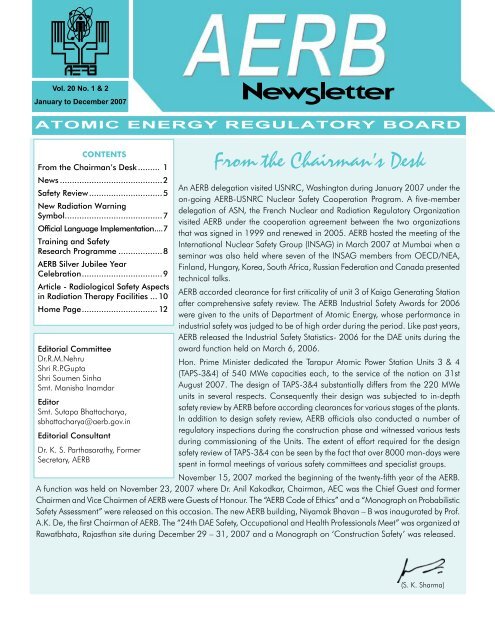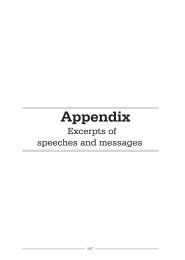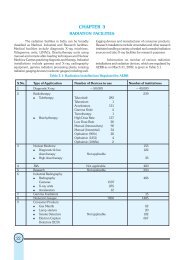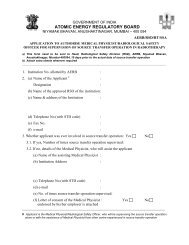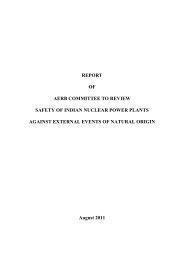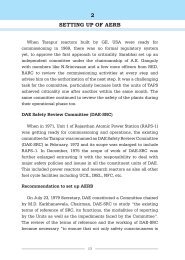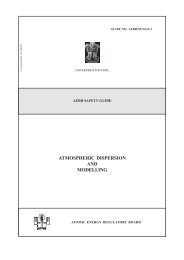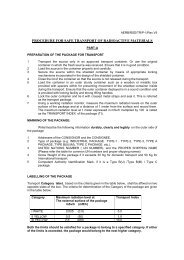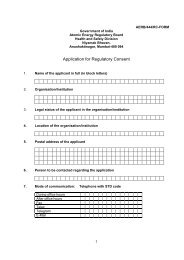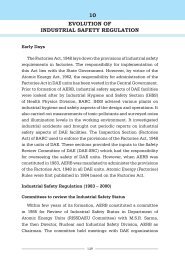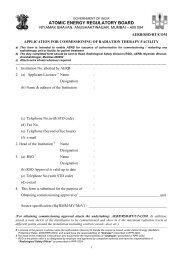Vol 20 No 1&2 - Atomic Energy Regulatory Board
Vol 20 No 1&2 - Atomic Energy Regulatory Board
Vol 20 No 1&2 - Atomic Energy Regulatory Board
Create successful ePaper yourself
Turn your PDF publications into a flip-book with our unique Google optimized e-Paper software.
<strong>Vol</strong>. <strong>20</strong> <strong>No</strong>. 1 & 2<br />
January to December <strong>20</strong>07<br />
ATOMIC ENERGY REGULATORY BOARD<br />
CONTENTS<br />
From the Chairman’s Desk.......... 1<br />
News...........................................2<br />
Safety Review..............................5<br />
New Radiation Warning<br />
Symbol........................................7<br />
Official Language Implementation....7<br />
Training and Safety<br />
Research Programme...................8<br />
AERB Silver Jubilee Year<br />
Celebration.................................9<br />
Article - Radiological Safety Aspects<br />
in Radiation Therapy Facilities.... 10<br />
Home Page............................... 12<br />
Editorial Committee<br />
Dr.R.M.Nehru<br />
Shri R.P.Gupta<br />
Shri Soumen Sinha<br />
Smt. Manisha Inamdar<br />
Editor<br />
Smt. Sutapa Bhattacharya,<br />
sbhattacharya@aerb.gov.in<br />
Editorial Consultant<br />
Dr. K. S. Parthasarathy, Former<br />
Secretary, AERB<br />
From the Chairman’s Desk<br />
An AERB delegation visited USNRC, Washington during January <strong>20</strong>07 under the<br />
on-going AERB-USNRC Nuclear Safety Cooperation Program. A five-member<br />
delegation of ASN, the French Nuclear and Radiation <strong>Regulatory</strong> Organization<br />
visited AERB under the cooperation agreement between the two organizations<br />
that was signed in 1999 and renewed in <strong>20</strong>05. AERB hosted the meeting of the<br />
International Nuclear Safety Group (INSAG) in March <strong>20</strong>07 at Mumbai when a<br />
seminar was also held where seven of the INSAG members from OECD/NEA,<br />
Finland, Hungary, Korea, South Africa, Russian Federation and Canada presented<br />
technical talks.<br />
AERB accorded clearance for first criticality of unit 3 of Kaiga Generating Station<br />
after comprehensive safety review. The AERB Industrial Safety Awards for <strong>20</strong>06<br />
were given to the units of Department of <strong>Atomic</strong> <strong>Energy</strong>, whose performance in<br />
industrial safety was judged to be of high order during the period. Like past years,<br />
AERB released the Industrial Safety Statistics- <strong>20</strong>06 for the DAE units during the<br />
award function held on March 6, <strong>20</strong>06.<br />
Hon. Prime Minister dedicated the Tarapur <strong>Atomic</strong> Power Station Units 3 & 4<br />
(TAPS-3&4) of 540 MWe capacities each, to the service of the nation on 31st<br />
August <strong>20</strong>07. The design of TAPS-3&4 substantially differs from the 2<strong>20</strong> MWe<br />
units in several respects. Consequently their design was subjected to in-depth<br />
safety review by AERB before according clearances for various stages of the plants.<br />
In addition to design safety review, AERB officials also conducted a number of<br />
regulatory inspections during the construction phase and witnessed various tests<br />
during commissioning of the Units. The extent of effort required for the design<br />
safety review of TAPS-3&4 can be seen by the fact that over 8000 man-days were<br />
spent in formal meetings of various safety committees and specialist groups.<br />
<strong>No</strong>vember 15, <strong>20</strong>07 marked the beginning of the twenty-fifth year of the AERB.<br />
A function was held on <strong>No</strong>vember 23, <strong>20</strong>07 where Dr. Anil Kakodkar, Chairman, AEC was the Chief Guest and former<br />
Chairmen and Vice Chairmen of AERB were Guests of Honour. The “AERB Code of Ethics” and a “Monograph on Probabilistic<br />
Safety Assessment” were released on this occasion. The new AERB building, Niyamak Bhavan – B was inaugurated by Prof.<br />
A.K. De, the first Chairman of AERB. The “24th DAE Safety, Occupational and Health Professionals Meet” was organized at<br />
Rawatbhata, Rajasthan site during December 29 – 31, <strong>20</strong>07 and a Monograph on ‘Construction Safety’ was released.<br />
(S. K. Sharma)
Press releases<br />
January 23, <strong>20</strong>07<br />
AERB Delegation Visits USNRC,<br />
Washington D.C., USA<br />
A nine-member delegation of <strong>Atomic</strong><br />
<strong>Energy</strong> <strong>Regulatory</strong> <strong>Board</strong> (AERB) led<br />
by Shri. S.K. Chande, Vice Chairman,<br />
AERB visited the United States Nuclear<br />
<strong>Regulatory</strong> Commission (USNRC),<br />
Washington, DC, USA during January 8<br />
to 17, <strong>20</strong>07 under the on-going Nuclear<br />
Safety Cooperation Program between<br />
the two regulatory bodies. Extensive<br />
discussions were held during the meeting<br />
on the topics of digital system reliability,<br />
new control room designs and proactive<br />
material degradation programmes.<br />
Indian experience in construction of<br />
Nuclear Power Plants was also presented.<br />
In addition, detailed discussions were<br />
held on the collaborative work that<br />
will be undertaken on benchmarking<br />
of computer codes for severe accident<br />
analysis and for assessment of ultimate<br />
load capacity of pre-stressed concrete<br />
containment structures through analysis<br />
of standard problems.<br />
The delegation also called upon the<br />
USNRC Chairman, Dr. Dale Klein and<br />
other commissioners and also visited<br />
Pilgrim Nuclear Power Station and<br />
Massachussette Institute of Technology<br />
(MIT) at Boston.<br />
This was the 8th meeting under the<br />
on-going nuclear safety co-operation<br />
programme between USNRC & AERB<br />
which started in February <strong>20</strong>03. The major<br />
areas covered under the programme<br />
include: Probabilistic Risk Assessment<br />
(PRA) Technology, Fire Safety, Licence<br />
Renewal, Design Modifications and<br />
Emergency Operating Procedures, New<br />
Reactor Designs and Severe Accident<br />
Analysis.<br />
As part of this co-operation programme,<br />
two officers of AERB were sent on a one<br />
year deputation at USNRC since August<br />
<strong>20</strong>06 and are working in the area of PRA<br />
Technology and its Applications.<br />
NEWS<br />
February 25, <strong>20</strong>07<br />
AERB ACCORDS CLEARANCE FOR<br />
FIRST CRITICALITY OF KAIGA<br />
UNIT - 3<br />
AERB accorded clearance on 25 February<br />
<strong>20</strong>07 for first criticality of Kaiga Unit-3<br />
located in Karwar district of Karnataka.<br />
Kaiga Units-1&2 are already in operation<br />
at this site for the last six years. Kaiga<br />
Unit-4 is in advanced stage of construction.<br />
Each of these PHWR units is of 2<strong>20</strong> MWe<br />
capacities.<br />
AERB issues clearances for nuclear<br />
power plants in different stages, viz.,<br />
siting, construction, commissioning and<br />
operation. Commissioning clearances<br />
are given for PHWRs in further sub-stages<br />
of light water testing, fuel loading, heavy<br />
water charging in coolant and moderator<br />
systems and first criticality. At each stage,<br />
AERB conducts a comprehensive review to<br />
ascertain that all the safety requirements<br />
are complied with.<br />
After achieving first criticality, reactor<br />
power is raised in steps and various tests<br />
are conducted at each step to ensure safe<br />
and smooth functioning of all reactor<br />
systems.<br />
Wednesday, March 7, <strong>20</strong>07<br />
AERB INDUSTRIAL SAFETY<br />
AWARDS<br />
<strong>Atomic</strong> <strong>Energy</strong> <strong>Regulatory</strong> <strong>Board</strong> (AERB)<br />
presents Industrial Safety Awards to the<br />
Department of <strong>Atomic</strong> <strong>Energy</strong> (DAE)<br />
Units every year whose performance in<br />
industrial safety area is of a high order.<br />
This year, the annual Industrial Safety<br />
Awards presentation function of AERB<br />
was held on March 6, <strong>20</strong>07. Shri J<br />
Ganguly, Executive Vice President from<br />
M/s Larsen & Toubro Ltd., Chennai,<br />
presented the Safety Awards for <strong>20</strong>06 to<br />
Bharatiya Nabhikiya Vidyut Nigam Limited<br />
(BHAVINI), Kalpakkam in Construction<br />
Group and to Narora <strong>Atomic</strong> Power<br />
Station, Narora, Rajasthan <strong>Atomic</strong> Power<br />
Station - 3&4, Rawatbhatata, Heavy<br />
Water Plant, Tuticorin and Indian Rare<br />
Earths Ltd. - Thorium Plant, Chatrapur in<br />
Production Units group.<br />
On this occasion, Shri S.K.Sharma,<br />
Chairman, AERB released a compilation<br />
of Industrial Safety Statistics- <strong>20</strong>06 for<br />
the DAE Units. This compilation provides<br />
the information on data on accidents<br />
and analysis of number of injuries and<br />
man-days loss caused by various factors.<br />
The data is also compared with units<br />
outside DAE. It is seen that Industrial<br />
Safety performance of DAE Units is<br />
significantly better as compared to other<br />
similar industries in the country. The<br />
number of injuries, injury rates and the<br />
number of fatalities reported were lowest<br />
in <strong>20</strong>06 among the past few years. The<br />
reduction in the number of injuries is the<br />
result of strengthening measures taken by<br />
all concerned. <strong>No</strong> case of occupational<br />
disease was reported for the year <strong>20</strong>06<br />
in the DAE units.<br />
Sunday, March 11, <strong>20</strong>07<br />
AERB HOSTS INSAG MEETING<br />
The eighth meeting of the International<br />
Nuclear Safety Group (INSAG) was<br />
hosted by <strong>Atomic</strong> <strong>Energy</strong> <strong>Regulatory</strong><br />
<strong>Board</strong> (AERB) during 12th to 16th<br />
March <strong>20</strong>07 in Mumbai. The INSAG<br />
is a group of international experts with<br />
high professional competence in the field<br />
of nuclear safety, working in regulatory<br />
organisations, research and academic<br />
institutions and the nuclear industry. INSAG<br />
provides recommendations and opinions<br />
on current and emerging nuclear safety<br />
issues to the IAEA, the nuclear community<br />
and the public. The members of present<br />
INSAG are from Canada, China, Finland,<br />
France, Germany, Hungary, India, Japan,<br />
Republic of Korea, Russian Federation,<br />
South Africa, Spain, United Kingdom and<br />
United States of America.<br />
Presently Shri S.K. Sharma, Chairman,<br />
AERB is the member of INSAG from India.<br />
Before him, Dr. Anil Kakodkar, Chairman<br />
<strong>Atomic</strong> <strong>Energy</strong> Commission (AEC), was<br />
the member of INSAG from India.<br />
The INSAG meeting was inaugurated<br />
by Chairman, AEC on 13th March<br />
<strong>20</strong>07. Chairman INSAG, Dr. Richard<br />
Meserve (Formerly Chairman, US<br />
Nuclear <strong>Regulatory</strong> Commission) and<br />
Dr. Taniguchi, Deputy Director General<br />
of IAEA, also made a courtesy call on
Dr. Anil Kakodkar Chairman, AEC.<br />
Apart from the intensive discussions on<br />
three days, the INSAG delegates also<br />
visited the Tarapur <strong>Atomic</strong> Power Station<br />
(TAPS) and BARC. In BARC, under a<br />
special Trombay Colloquium, Dr. Richard<br />
Meserve, Dr. Taniguchi and Dr. Carlos<br />
Alejaldre, Deputy Director General of<br />
ITER delivered technical talks on The<br />
Nuclear Renaissance, Global Partnership<br />
for Nuclear Safety and Security and<br />
International Thermonuclear Experiment<br />
Reactor (ITER) respectively. A Press Meet<br />
has also been organized at BARC on<br />
15th March.<br />
A seminar where seven of the INSAG<br />
members from OECD/NEA, Finland,<br />
Hungary, Korea, South Africa, Russian<br />
Federation and Canada presented<br />
technical talks on a variety of current<br />
topics of interest. The INSAG meeting<br />
provided a good opportunity to Indian<br />
nuclear Scientists and engineers to<br />
interact with this group of international<br />
experts.<br />
Thursday, May 10, <strong>20</strong>07<br />
FRENCH NUCLEAR REGULATORY<br />
DELEGATION VISITS ATOMIC<br />
ENERGY REGULATORY BOARD<br />
A five-member delegation of the French<br />
Nuclear and Radiation <strong>Regulatory</strong><br />
Organization, namely, Nuclear Safety<br />
Authority (ASN) led by Mr. Olivier Gupta,<br />
Head of the Direction of Nuclear Power<br />
Plants of ASN visited the <strong>Atomic</strong> <strong>Energy</strong><br />
<strong>Regulatory</strong> <strong>Board</strong> (AERB) during May<br />
8 - 10, <strong>20</strong>07. This visit was under the<br />
Agreement between the two organizations<br />
that was signed in July 1999 on Exchange<br />
of Information and Co-operation in<br />
the Regulation of Nuclear Safety and<br />
Radiation Protection. In the present<br />
visit, a seminar on ‘Pressurized Water<br />
Reactors’ was organized under the<br />
said agreement. The topics covered<br />
in the seminar were: French Side:<br />
Organization and Functions of ASN,<br />
Licensing and Review Process of EPR,<br />
Safety Objectives and Safety Approach<br />
and Requirements for New Reactors,<br />
EPR Design Assessment with respect to<br />
Design Basis Event, External Hazard and<br />
Instrumentation and Control, Practically<br />
NEWS<br />
Eliminated Events and Severe Accident<br />
Management. Indian Side: Organization<br />
and Functions of AERB, Safety Review<br />
of Kudankulam Nuclear Power Project<br />
(KK-NPP), An approach to Design Safety<br />
Review of New Design: Advanced Heavy<br />
Water Reactor (AHWR): A case study<br />
and Pressurized Water Reactors; Indian<br />
Perspective.<br />
Large number of scientists and engineers<br />
from AERB, BARC, IGCAR and NPCIL<br />
participated in the seminar. The<br />
presentations and discussions held in<br />
the seminar led to a better appreciation<br />
of regulatory practices and safety review<br />
approaches followed in the two regulatory<br />
bodies, safety objectives for new reactors<br />
and safety assessment of reactors with<br />
evolutionary new design features.<br />
June 2, <strong>20</strong>07<br />
MATERIAL SEIZED BY LUCKNOW<br />
POLICE IS NOT URANIUM<br />
With reference to a news item regarding<br />
“seizure” of 700 grams of uranium by<br />
Lucknow Police that appeared in certain<br />
sections of the Press on June 1, <strong>20</strong>07.<br />
AERB deputed two experts to Lucknow<br />
to ascertain the nature of the seized<br />
material.<br />
Preliminary examination of the material<br />
indicated that the material seized by the<br />
police is not uranium. The material was<br />
later tested in Bhabha <strong>Atomic</strong> Research<br />
Centre (BARC), Mumbai to identify its<br />
chemical compositions and was found to<br />
be organic ion-exchange resin.<br />
Thursday, August 30, <strong>20</strong>07<br />
DESIGN SAFETY REVIEW OF<br />
TAPS-3&4 BY AERB<br />
Construction of Tarapur <strong>Atomic</strong> Power<br />
Station Units 3 & 4 (TAPS 3&4) was started<br />
in March <strong>20</strong>00 and Unit-4 became<br />
operational in March <strong>20</strong>05, i.e. 5 years<br />
after start of construction which is the<br />
shortest period for any nuclear power<br />
unit in the country so far. Unit-3 became<br />
operational in May <strong>20</strong>06.<br />
These units of 540 MWe capacities each<br />
are of totally indigenous design and<br />
are based on Pressurised Heavy Water<br />
Reactors (PHWRs), which is the mainstay<br />
of nuclear power programme in the<br />
country. While TAPS 3 & 4 design has<br />
evolved from the experience of 2<strong>20</strong> MWe<br />
PHWR units, their design substantially<br />
differs from the 2<strong>20</strong> MWe units in<br />
several respects and it also incorporates<br />
several innovative and state-of-the<br />
art safety features. Consequently the<br />
design of TAPS 3 & 4 was subjected to<br />
an elaborate and in-depth safety review<br />
by the <strong>Atomic</strong> <strong>Energy</strong> <strong>Regulatory</strong> <strong>Board</strong><br />
(AERB) before according clearances for<br />
various stages of the plants viz. siting,<br />
start of construction, first criticality and<br />
operation at high power.<br />
The safety reviews were conducted<br />
through the established AERB practice of<br />
multi-tier reviews. This involved elaborate<br />
design safety review by the Project Design<br />
Safety Committee and its various specialist<br />
groups, followed by Review by the AERB’s<br />
Advisory Committee for Project Safety<br />
Review and final clearance by the <strong>Board</strong><br />
of AERB. In addition to design safety<br />
review, AERB officials also conducted a<br />
number of regulatory inspections during<br />
the construction phase and witnessed<br />
various tests during commissioning of the<br />
Units. The extent of effort required for the<br />
design safety review of TAPS 3 & 4 can<br />
be seen by the fact that over 8000 man<br />
days were spent in formal meetings of<br />
various safety committees and specialist<br />
groups. This is in addition to substantial<br />
time spent by individual experts outside<br />
formal meetings.<br />
This press release was issued by AERB for<br />
general information on the occasion of<br />
dedication of TAPS 3 & 4 to the nation by<br />
the Hon. Prime Minister on 31st August<br />
<strong>20</strong>07.
During the period Jan-Dec <strong>20</strong>07, AERB<br />
issued the following regulatory documents.<br />
In drafting these documents, extensive use<br />
was made of the information contained<br />
in the relevant safety standards of the<br />
International <strong>Atomic</strong> <strong>Energy</strong> Agency.<br />
• Management of Radioactive Waste<br />
(AERB/NRF/SC/RW).<br />
This safety Code is developed for<br />
radioactive waste that is generated<br />
during operation, maintenance and<br />
decommissioning of nuclear and radiation<br />
facilities. This Safety Code establishes the<br />
requirements, which shall be fulfilled for<br />
the safe management of solid, liquid<br />
and gaseous radioactive waste from<br />
generation through disposal. The Code<br />
specifies basic requirements for the safe<br />
management of radioactive waste from<br />
various nuclear and radiation facilities.<br />
The document stipulates requirements<br />
in design, construction and operation of<br />
waste management facilities including<br />
radiation protection aspects and the<br />
responsibilities of different agencies<br />
involved.<br />
• Management of Radioactive<br />
Waste from Mining and Milling of<br />
Uranium and Thorium (AERB/NF/<br />
SG/RW-5).<br />
This safety guide provides guidance<br />
for ensuring safety in handling and<br />
disposal of radioactive waste generated<br />
from mining and milling of uranium<br />
and thorium. This Guide addresses<br />
administrative, legal and regulatory<br />
framework and radiation protection in the<br />
management of radioactive waste from<br />
mining and processing of uranium ore,<br />
mining and processing of monazite and<br />
thorium. It also provides guidance for the<br />
management of decommissioning waste<br />
of such facilities and monitoring and<br />
regulatory control during pre-operation,<br />
operation, closure and post-closure<br />
period.<br />
• Radiological Safety in Uranium<br />
NEWS<br />
SAFETY DOCUMENTS PUBLISHED<br />
Mining and Milling (AERB/FE-FCF/<br />
SG-2).<br />
This safety guide provides guidance<br />
for ensuring radiological safety in<br />
site selection, design, construction,<br />
commissioning, operation, maintenance,<br />
waste management, decommissioning and<br />
controlling of radiation and occupational<br />
health hazards of the uranium mining and<br />
milling plants. The document addresses<br />
the administrative, legal and regulatory<br />
framework, radiological monitoring<br />
requirements, occupational health safety<br />
aspects and emergency plan for mining<br />
and processing of uranium with an<br />
objective of protecting workers, public<br />
and environment from radiological and<br />
environmental hazards.<br />
• AERB Safety Guide on Safety<br />
in Thorium Mining And Milling<br />
(AERB/NF/SG/IS-6)<br />
This safety guide depicts the safety<br />
procedures and systems to be followed<br />
during thorium mining and milling, with<br />
the objective of protecting workers, public<br />
and environment from radiological,<br />
industrial and environmental hazards. The<br />
safety procedures include site selection,<br />
design and construction of the equipment.<br />
It provides guidelines on regulatory control<br />
during pre-operation, operation, closure<br />
and post-closure period and management<br />
of decommissioning. The document<br />
addresses the administrative, legal and<br />
regulatory framework, radiological<br />
monitoring requirements, occupational<br />
health safety aspects and emergency plan<br />
for mining and processing of Thorium.<br />
• AERB Safety Guide on Consenting<br />
Process for Nuclear Power Plants<br />
and Research Reactors (AERB/<br />
NPP&RR/SG/G-1)<br />
This safety guide defines the regulatory<br />
consenting process at all the major<br />
stages of a nuclear power plant/research<br />
reactor. It covers in detail the information<br />
required to be included in the submissions<br />
to AERB, mode of document submissions<br />
and their classification, and areas of<br />
review and assessment for granting the<br />
regulatory consent.<br />
• AERB Safety Manual on <strong>Regulatory</strong><br />
Inspection and Enforcement in<br />
Nuclear Power Plants and Research<br />
Reactors (AERB/NPP&RR/SM/G-1).<br />
This safety manual elaborates the<br />
organization, requirements and methods<br />
for conducting <strong>Regulatory</strong> Inspections of<br />
the nuclear power plants and research<br />
reactors. It covers the suggested types of<br />
enforcement actions. It is also intended<br />
to assist all the participating agencies in<br />
fulfilling the stipulated requirements of the<br />
relevant AERB safety code and guide.<br />
• <strong>Regulatory</strong> Inspection and<br />
Enforcement in Nuclear Fuel Cycle<br />
Facilities and Related Industrial<br />
Facilities other than Nuclear Power<br />
Plants and Research Reactors<br />
(AERB/NF/SM/G2).<br />
This safety manual elaborates the<br />
organization, requirements and methods<br />
of inspection programme of the nuclear<br />
fuel cycle facilities and related industrial<br />
facilities. This manual also covers the<br />
suggested types of enforcement action.
BOARD METTINGS<br />
Three meetings of <strong>Atomic</strong> <strong>Energy</strong><br />
<strong>Regulatory</strong> <strong>Board</strong> (AERB) were held during<br />
<strong>20</strong>07; one at UCIL Jaduguda, Jharkhand<br />
on March 23, <strong>20</strong>07, second at AERB,<br />
Mumbai on June 22, <strong>20</strong>07 and the third<br />
at Kaiga site on October 15, <strong>20</strong>07.<br />
In the meeting held at Jaduguda, the<br />
<strong>Board</strong> reviewed the work carried out by<br />
AERB in the last quarter of <strong>20</strong>06, the<br />
proposal for installation of windmills<br />
beyond Exclusion Zone and within 5 km<br />
sterilized zone at KK-NPP and the status<br />
of safety review and commissioning of<br />
Kaiga Unit-3.<br />
Detailed discussion was held on the<br />
causes of two fatal accidents during<br />
March <strong>20</strong>07 at the construction sites of<br />
PFBR at Kalpakkam; one caused by fall of<br />
a person from height and the other due to<br />
a person being hit by a moving machine.<br />
The <strong>Board</strong> noted that Chairman, AERB<br />
had directed PFBR management to stop<br />
civil construction work till the incident<br />
was reviewed by the <strong>Board</strong>. The <strong>Board</strong><br />
decided that BHAVINI should submit a<br />
report bringing out the steps taken to<br />
prevent recurrence of such accidents and<br />
for enhancing the level of supervision<br />
of day-to-day work. An overall review<br />
of industrial safety in civil construction<br />
work should also be carried out. AERB<br />
will then conduct a special regulatory<br />
inspection of PFBR construction site.<br />
The <strong>Board</strong> authorized Chairman, AERB<br />
to issue the clearance for restart of the<br />
construction work if the report is found<br />
satisfactory and if there is confirmation<br />
of compliance of recommendations from<br />
AERB inspection.<br />
The <strong>Board</strong> visited the Tailing Ponds and<br />
the Ore Processing Plant at Jaduguda,<br />
the Banduhurang Open Cast Mine,<br />
the Turamdih Mine and Mill and the<br />
Narwapahar Mine.<br />
In the <strong>Board</strong> Meeting held on June 22,<br />
<strong>20</strong>07 at Mumbai, the <strong>Board</strong> granted<br />
approval for Erection of Major Equipments<br />
at KK-NPP Unit-2. The <strong>Board</strong> also gave<br />
clearance for publication of AERB Safety<br />
Code on ‘Management of Radioactive<br />
Waste’, AERB/NRF/SC/RW. The draft<br />
SAFETY REVIEW<br />
of AERB Annual Report <strong>20</strong>06-<strong>20</strong>07<br />
was reviewed and the <strong>Board</strong> approved<br />
its submission to the <strong>Atomic</strong> <strong>Energy</strong><br />
Commission.<br />
In the third meeting held on October<br />
15, <strong>20</strong>07 at Kaiga Site, the <strong>Board</strong><br />
discussed the proposal for revision of<br />
the size of Exclusion Zone around NPPs.<br />
The <strong>Board</strong> was informed about the<br />
suspension of construction activities for<br />
RAPS-5&6 during June 29th to July 5th,<br />
<strong>20</strong>07 arising from a fatal accident. The<br />
<strong>Board</strong> endorsed the action of AERB, and<br />
suggested that the industrial accidents at<br />
sites should be prevented by all means<br />
available to NPCIL and AERB. <strong>Board</strong> also<br />
discussed the analysis of KAPS-2 incident<br />
involving double-ended rupture of 10 %<br />
feed water line to steam generator-4 due<br />
to Flow Assisted Corrosion (FAC). <strong>Board</strong><br />
suggested that FAC should be understood<br />
in depth by conducting experiments and<br />
performing analysis by mathematical<br />
modeling based on computational fluid<br />
dynamics covering the effects like pipe<br />
fittings, welding protrusions and other<br />
conditions leading to the development<br />
of eddies and the effect of these on FAC.<br />
Development of precise effect of water<br />
chemistry on different materials, leading<br />
to FAC should also be studied. The <strong>Board</strong><br />
visited the KGS operating units and KGS-<br />
4 which is under construction.<br />
AUTHORIZATIONS ISSUED<br />
¾ Site proposed for Tummalapalle<br />
Process Plant (Mill) of UCIL.<br />
¾ Siting and Construction of Technology<br />
Demonstration Plant (TDP) at Rashtriya<br />
Chemicals & Fertilizers (RCF),<br />
Chembur, Mumbai to be operated<br />
by Heavy Water <strong>Board</strong>.<br />
¾ Construction of a Medical Cyclotron<br />
facility based on a 30 MeV 500 µA<br />
proton accelerator on a plot of land<br />
situated near the Peerless Hospital<br />
at Chakgaria, South 24 – Parganas,<br />
West Bengal.<br />
¾ Siting clearance for Radiation<br />
Processing Facility for Agricultural<br />
Products adjacent to Flower Mandi of<br />
Choithram Mandi Complex, Indore.<br />
¾ Continuation of storage of spent fuel<br />
in the dry storage concrete casks of<br />
old design at RAPS 1&2 upto <strong>20</strong>15<br />
¾ Clearance for Erection of Major<br />
Equipment for Kudankulam Nuclear<br />
Power Project (KK NPP) Unit # 2.<br />
¾ Clearance for commencement of<br />
“Revamping activities of Uranium<br />
Oxide Plant (UOP)” at Nuclear Fuel<br />
Complex, Hyderabad.<br />
¾ Operation of Kaiga Unit – 3 upto 90%<br />
Full Power (FP) –May 3, <strong>20</strong>07.<br />
¾ Authorization for hot conditioning and<br />
light water commissioning of RAPP-5<br />
of Rajasthan <strong>Atomic</strong> Power Project<br />
(RAPP-5) was issued on October 12,<br />
<strong>20</strong>07.<br />
¾ Construction consents for Rajasthan<br />
<strong>Atomic</strong> Power Project Unit - 5&6<br />
(RAPP 5&6) were suspended on June<br />
29, <strong>20</strong>07 subsequent to 3 fatalities<br />
resulting due to similar conditions<br />
occurred in a period of 6 months.<br />
Suspension of construction consents<br />
was revoked on July 05, <strong>20</strong>07 after<br />
detailed safety review of corrective<br />
actions carried out by NPCIL.<br />
¾ Authorisation for trial operation of 12<br />
MeV microtron at max. <strong>20</strong> mA current<br />
in IMA building of RRCAT was granted<br />
for a period of one year.<br />
¾ Authorisation was issued for<br />
commissioning of Boron Enrichment<br />
Exchange Distillation (BEXD) facility at<br />
HWP-Talcher on June <strong>20</strong>,<strong>20</strong>07.<br />
¾ Permission for Cold Commissioning<br />
run of Turamdih ore processing plant<br />
with inactive material was granted<br />
with certain stipulations to Uranium<br />
Corporation of India Limited on June<br />
23, <strong>20</strong>07.<br />
¾ Authorisation for safe disposal of<br />
radioactive waste from NUOFP was<br />
issued on July <strong>20</strong>,<strong>20</strong>07 and valid<br />
upto December 31,<strong>20</strong>09<br />
¾ Authorisation for construction of<br />
HEWAC facility at HWP, Kota was<br />
granted by Chairman, AERB on August<br />
28, <strong>20</strong>07 with certain stipulations.<br />
The authorisation is valid till end of<br />
August <strong>20</strong>12.<br />
.....contd. in page 7
SAFETY REVIEW<br />
REGULATORY INSPECTIONS CARRIED OUT DURING THE PERIOD, JAN-DEC <strong>20</strong>07<br />
Unit<br />
Number of<br />
Inspections<br />
UCIL-Jaduguda, Narwapahar, Bhatin, Turamdih, Banduhurang, Bagjata mines<br />
2 each<br />
UCIL-Mohuldih mine 1<br />
UCIL, Jaduguda uranium mill, Jharkhand 3<br />
UCIL, Turamdih uranium mill, Jharkhand 2<br />
IREL, OSCOM, Chatrapur, Orissa 2<br />
IREL, Udyogamandal, Kerala 2<br />
IREL, Manavalakurichi, Tamilnadu 1<br />
IREL, Chavara, Kerala 1<br />
NFC, Hyderabad, A.P. 2<br />
HWPs-Talcher, Hazira, Thal, Manuguru, Tuticorin, Baroda<br />
1 each<br />
RAPS - 1&2, RAPS – 3&4, MAPS -1&2, KGS – 1&2, KAPS – 1&2, TAPS – 1&2, TAPS – 3&4<br />
2 each<br />
Narora <strong>Atomic</strong> Power Station, U.P. 4<br />
RAPP Cobalt Facility (RAPPCOF), Rawatbhata, Rajasthan 1<br />
Fast Breeder Test Reactor, KAMINI and IGCAR facilities<br />
1 each<br />
Rajasthan <strong>Atomic</strong> Power Project 5&6, Rawatbhata (RAPP 5&6) 3<br />
Kudankulam Nuclear Project (KKNP), Tamil Nadu 3<br />
Kaiga Projects - 3&4 2<br />
Prototype Fast Breeder Reactor (PFBR), Kalpakkam, Tamil Nadu 3<br />
Demonstration Fuel Reprocessing Plant (DFRP), Kalpakkam, Tamil Nadu 3<br />
Interim Fuel Storage Building (IFSB), Kalpakkam, Tamil Nadu 1<br />
RAPP 5&6, Kiga-3&4, KKNP, PFBR, DFRP, HEWAC, NFC (ZC) -Pazhayakal projects<br />
(Special monthly inspections on Industrial Safety) 37<br />
Raja Ramanna Centre of Advanced Technology –Indore (RRCAT), INdore, M.P. 1<br />
Variable <strong>Energy</strong> Cyclotron Centre (VECC), Kolkata, W.B. 2<br />
Electronics Corporation of India Ltd.-Hyderabad (ECIL), Hyderabad, A.P. 1<br />
Beach Sand Minerals (BSM) Facilities 5<br />
Industrial Radiography facilities 44<br />
Medical Installations<br />
• Nuclear Medicine 37<br />
• Diagnostic X Rays 41<br />
• Radiotherapy Facilities 12<br />
Gamma Irradiators 11<br />
Nucleonic Gauges 16<br />
Sl.<strong>No</strong>. Name & Designation<br />
1. Shri. Bibekananda Misra, SO(C), RSD<br />
2. Shri. Hariharan Seshadri, SO(D), SRI<br />
3. Smt. Prabha M. Das, Steno Gr. III, RSD<br />
4. Shri. O.S. Seikh Mansoor Ali, SO(E), SRI<br />
5. Shri. P.K. Dixit, SO(C), RSD<br />
6. Shri. C. Anandan, SO(D), SRI<br />
7. Shri. P.K. Baburajan, SO(E), SADD<br />
8. Shri. V.V. Muthekar, SO(D), C&SED<br />
9. Shri. V.M. Thomas, AO-III, Admn.<br />
10. Shri. Megh Raj Singh, SO(C), RSD<br />
11. Shri. Ashis Kumar Panda, SO(E), IPSD<br />
Personnel Joined<br />
12. Shri. Animesh Pal, SO(D), IPSD<br />
13. Shri. Suresh Kumar, SO(C), SRI<br />
14. Shri. Surendra Jain, SO(C), ITSD<br />
15 Shri. A.B.Gerira, APO (Gen), Admn.<br />
16. Shri. J.V.K.Sunil Kumar, SO(C), RSD<br />
17. Shri. Nishant Kumar Sangam, SO(C), OPSD<br />
18. Shri. Sunil L.S. Pagar, SO(C), OPSD<br />
19. Shri. Pankaj Gupta, SO(C), IPSD<br />
<strong>20</strong>. Shri. Anuj Kumar Deo, SO(C), ITSD<br />
21. Smt. Vasantha Sasi, Accounts Officer<br />
22. Shri. J. Vincent Kumar, DCA<br />
Personnel Retired<br />
Sl.<strong>No</strong>. Name & Designation<br />
1. Shri. J. Prasad, SO(G), IPSD (retired)<br />
2. Shri. K.D. Pushpangadan, SO(E), RSD (retired)<br />
3. Smt. P. Samuel, Sr. Accts. Officer, Accounts<br />
(retired)<br />
4. Shri. C.K.Vijayan, AO-II, Admn. (retired)<br />
5. Shri.S.S. PrabhuZantye, DCA (retired)<br />
6. Shri. G. Janakiraman, SO(F), SRI (retired)<br />
7. Smt. Sutapa Bhattacharya, SO(G), NPSD (Retired<br />
<strong>Vol</strong>untary)
NEW RADIATION WARNING SYMBOL<br />
New ISO Standard - Supplementary Ionizing-Radiation Warning Symbol<br />
Figure-1. Supplementary Ionizing-<br />
Radiation Warning Symbol<br />
A new radiation warning symbol to<br />
supplement the existing trefoil symbol<br />
has been published by ISO as Standard<br />
21482- Ionizing-Radiation Warning<br />
–Supplementary symbol. The new symbol<br />
is the result of a multi-year effort by the<br />
IAEA to develop a universal radiation<br />
warning symbol that anyone anywhere<br />
will understand the message of “Danger-<br />
Stay Away”. The new symbol was<br />
developed with human factor experts,<br />
graphic artists, and radiation protection<br />
experts. Many possible symbols were<br />
initially tested in international children,<br />
and then those symbols that were most<br />
successful in conveying the desired<br />
message were tested further by the<br />
Gallup Institute in both people with<br />
limited education and those educated in<br />
11 countries around the world. The new<br />
symbol universally conveyed the intended<br />
message regardless of the person’s age,<br />
education or cultural background.<br />
The symbol (Fig.1) is intended for IAEA<br />
Category 1, 2 and 3 sources defined as<br />
dangerous sources capable of causing<br />
death or serious injury. The symbol should<br />
be placed on the device housing the<br />
source, as a warning not to dismantle<br />
the device or to get any closer. Where<br />
practical, it should be placed under the<br />
From page 5<br />
¾ Authorisation for siting and construction<br />
of Versatile Solvent Production Plant<br />
(VSPP) at HWP-Talcher was granted<br />
on September 11, <strong>20</strong>07.<br />
¾ Authorisation for development of<br />
Mohuldih undergrounds mine of UCIL<br />
in Sarikela district of Jharkhand on<br />
October 24, <strong>20</strong>07.<br />
¾ Authorisation for construction of<br />
10,000 tpa Monazite Processing Plant<br />
(MoPP) at IREL, OSCOM was granted<br />
device cover such that it is not visible<br />
under normal use but would be visible<br />
if anyone attempts to disassemble the<br />
device. The symbol is not intended for<br />
doors or shipping containers.<br />
Many source manufactures have<br />
agreed to use the symbol on newly<br />
manufactured large sources such as<br />
irradiators, teletherapy heads and<br />
industrial radiography units. Strategies<br />
to place the symbol on existing large<br />
sources are being developed by the<br />
IAEA. The standard can be obtained at<br />
www.iso.org.<br />
Information: Carolyn Mac Kenzie,<br />
c.mackenzie@iaea.org<br />
by Chairman, AERB on October 24,<br />
<strong>20</strong>07 with certain stipulations.<br />
¾ Restart of NAPS-1 after EMCCR<br />
campaign<br />
¾ Authorization for regular operation of<br />
TAPS-3&4<br />
¾ Authorisation for operation of<br />
THRUST – II, IREL Udyogamandal<br />
was approved by SARCOP during<br />
its 549th meeting held on April 11,<br />
<strong>20</strong>07.<br />
OFFICIAL LANGUAGE IMPLEMENTATION<br />
AERB continued its efforts to ensure<br />
effective implementation of official<br />
language policy and enhance the use<br />
of Hindi in official work. An Inspection<br />
Team was constituted in January <strong>20</strong>07 to<br />
monitor the progress of use of Hindi in<br />
official work. Hindi stenography training<br />
class commenced in February, <strong>20</strong>07<br />
and nine Stenographers of AERB were<br />
trained. Fourteen officers/staff Members<br />
of AERB were trained for Pragya /Praveen<br />
examinations under the Hindi Teaching<br />
Scheme, Ministry of Home Affairs, Govt.<br />
of India.<br />
In order to train employees to write letters,<br />
notes etc. in Hindi, two Hindi Workshops<br />
were organized jointly with DPS, DCSE&M,<br />
HWB, Mumbai. Four employees of AERB<br />
attended these workshops.<br />
To create a conducive atmosphere<br />
to encourage the use of Hindi by the<br />
officers and staff, 11 competitions such<br />
as Story Writing, Essay and Slogan<br />
Writing, Scientific & Technical Translation,<br />
<strong>No</strong>ting & Drafting, Quiz, Elocution, etc.<br />
in Hindi were organized during February,<br />
<strong>20</strong>07 and September, <strong>20</strong>07. Forty-four<br />
AERB Officials participated in these<br />
Competitions.<br />
Hindi Day, Hindi Week and Prize<br />
Distribution function was organized<br />
from 10.9.<strong>20</strong>07 to 14.9.<strong>20</strong>07 by the<br />
Joint Official Language Co-ordination<br />
Committee of DAE units of Mumbai (AERB,<br />
DPS, DCSEM, and HWP). Elocution,<br />
Poetry Recitation and Quiz Competitions<br />
in Hindi were organized. AERB team<br />
participated in Quiz Programme and<br />
stood second.<br />
AERB library procured 55 books in<br />
Hindi on various topics to encourage<br />
and develop interest in scientific and<br />
literary works in Hindi. During the year,<br />
2 documents have been printed in Hindi<br />
and 4 documents have been translated<br />
into Hindi.<br />
To promote the use of Hindi in AERB,<br />
appropriate ISM-<strong>20</strong>00 Software tools<br />
were installed in all the computers in<br />
AERB. Hindi version of Annual Report<br />
of AERB was published and circulated<br />
to DAE units, academic and R&D<br />
institutes, medical institutions and media<br />
personnel.
TRAINING AND SAFETY RESEARCH PROGRAMME<br />
IN-HOUSE TRAINING ACTIVITY<br />
An in-house Training Programme was<br />
conducted for 21 participants during<br />
September <strong>20</strong>07 to <strong>No</strong>vember <strong>20</strong>07.<br />
A total of 57 lectures were delivered.<br />
Feedback was collected using the<br />
parameters: Administration of the<br />
Programme, Applicability, Content,<br />
Environment, Faculty, Course Length,<br />
Audio-Visuals and Overall Rating. The<br />
feedback from the participants ranged<br />
between A (Excellent) and B (Good) for<br />
majority of the lectures. The performance<br />
of participants was evaluated on regular<br />
basis through 13 examinations.<br />
AERB REFRESHER COURSE<br />
A Refresher Course was conducted<br />
involving a series of lectures on various<br />
aspects of “Fast Breeder Reactor<br />
Technology and Engineering Aspects<br />
of Prototype Fast Breeder Reactor” for<br />
the benefit of AERB Staff. In-house faculty<br />
members and officers from IGCAR<br />
delivered four lectures in the series<br />
on topics ‘PFBR Core Engineering<br />
Design ’, ‘Design of Reactor Assembly<br />
Components’, ‘Sodium Circuits’ and<br />
‘Shutdown Systems and Decay Heat<br />
Removal System’.<br />
AERB COLLOQUIA<br />
Two lectures were delivered, by Dr.<br />
B.S. Rao, former Head, Radiological<br />
Physics and Advisory Division,<br />
BARC, on ‘Radiobiological basis<br />
of ICRP’ and ‘Recommendations<br />
and Highlights of current ICRP and<br />
Recommendations’.<br />
Shri A. R. Sundarajan, Former Director,<br />
Radiation Safety Division, AERB gave<br />
a talk on “The Ecstasy and Agony<br />
of Two Alpha Emitters Radium &<br />
Plutonium”, on February 27, <strong>20</strong>07. This<br />
talk gave a historical account of the early<br />
unscrupulous and scandalous exploitation<br />
of these two highly radioactive elements<br />
soon after their discoveries.<br />
A talk on “Fifty Years of Radiation<br />
Protection” was presented by Shri. G.<br />
Venkataraman, former Head, Radiation<br />
Protection Services Division of BARC.<br />
This talk focused on the development of<br />
radiation protection measures in medical,<br />
industrial and research applications of<br />
radiation during the last fifty years.<br />
‘Effective Communication Techniques’<br />
by Shri. R. Bharathan from BARC<br />
highlighting on how to listen while<br />
hearing and speak while talking. The<br />
talk covered various day-to-day incidents<br />
and situations related to communication<br />
gaps and how they can be used in an<br />
effective way.<br />
The talk on ‘Recent Developments<br />
in Radiobiological Research:<br />
Implications to Human Health Risk<br />
and Radioprotection’ by Dr. K.P. Mishra,<br />
former Head, Radiobiology and Health<br />
Services Division, BARC, highlighted<br />
the present emerging new perspectives<br />
in radiobiology with implications to<br />
risk assessment and radioprotection<br />
standards for human health.<br />
A talk on ‘Bomb Detection & Disposal’<br />
was delivered by Shri. R.P.Raju, Manager<br />
(Protocol and Public Relegations) NPCIL,<br />
highlighting the various techniques<br />
involved in the detection of bombs,<br />
various precautions by the public and<br />
disposal methods.<br />
‘<strong>Regulatory</strong> Activities Prior to<br />
Formation of AERB’ by Shri S. D. Soman,<br />
Ex- Chairman, AERB. This talk highlighted<br />
the regulatory activities for nuclear and<br />
radiation facilities prior to the formation<br />
of AERB. This talk also addressed how<br />
the regulatory procedures have evolved in<br />
AERB over a time period for ensuring the<br />
safety of nuclear and radiation facilities.<br />
‘Compact Reprocessing facility for<br />
Advanced fuels in Lead shielded cell<br />
(CORAL) Operations: Stepping-Stone<br />
for Fast Reactor Fuel Reprocessing<br />
Technology’ by Shri R. Natarajan, Group<br />
Director, Reprocessing Group, IGCAR,<br />
Kalpakkam. This talk addressed various<br />
aspects involved in the reprocessing of<br />
spent fuel, experience of reprocessing of<br />
FBTR fuel, CORAL facility for advanced<br />
fuels in Lead Shielded Mini Cell, design<br />
aspects of the Demonstration Fast Reactor<br />
Fuel Reprocessing Plant (DFRP) and the<br />
Fast reactor fuel Reprocessing Plant (FRP).<br />
SAFETY RESEARCH PROGRAMME<br />
The AERB Committee for Safety Research Programmes (SRP) met three times on 13th June <strong>20</strong>07, <strong>20</strong>th/21st July <strong>20</strong>07 and 8th October<br />
<strong>20</strong>07. Eight new project proposals were taken up for discussion and following five projects were approved (Table 1). Committee also<br />
approved the renewal of 6 on-going projects. Eighteen Principal Investigators of the projects made presentations to CSRP.<br />
Table 1: AERB approved Projects in <strong>20</strong>07<br />
S.<strong>No</strong>. Title of the project Institution<br />
1. Enhancement of Durability of Concrete Structures using Microbes. Thapar Institute of Engineering &<br />
Technology, Patiala<br />
2. Validation of Gel Dosimetry as 3D Verification Tool for Highly Conformal AIIMS, New Delhi<br />
Radiotherapy Techniques.<br />
3. Multi-Material Multi-Rod 3-D Temperature Distribution in a Fuel Bundle with College of Engineering & Technology,<br />
Temperature/Time Dependent Thermo-Physical Property with Dirichlet/Neumann/ Biju Patnaik University<br />
Robbins and their combination as Boundary Conditions.<br />
4. Development of Model to Calculate Radiative Heat Transfer in Fuel IIT-Guwahati, Guwahati<br />
Channels of PHWRs.<br />
5. Development of a Thermo Luminescence Dosimeter (TLD) based on Borate Glass: Thoubal College, Manipur<br />
Implication to Clinical Dosimetry.
AERB SILVER JUBILEE YEAR CELEBRATION<br />
<strong>No</strong>vember 15, <strong>20</strong>07 marked the<br />
beginning of the twenty-fifth year of the<br />
<strong>Atomic</strong> <strong>Energy</strong> <strong>Regulatory</strong> <strong>Board</strong>. In the<br />
year 1981, The Meckoni Committee had<br />
recommended for the creation of AERB by<br />
the Central Government with the powers<br />
to lay down safety standards and framing<br />
rules and regulations for enforcing<br />
regulatory and safety requirements<br />
envisaged under the <strong>Atomic</strong> <strong>Energy</strong><br />
Act, 1962. On <strong>No</strong>vember 15, 1983,<br />
the AERB was officially set up through a<br />
Gazette notification.<br />
A series of metamorphoses have taken<br />
place over the years to give AERB its<br />
present outlook. AERB started its work<br />
in 1983, with its office located at the<br />
Anushakti Bhavan, with a handful of<br />
employees. AERB has now grown up to an<br />
organization housing about two hundred<br />
employees located at Niyamak Bhavan<br />
in Anushaktinagar, Mumbai. Over the<br />
years, AERB has firmly established itself<br />
to meet the challenges of regulating the<br />
fast expanding nuclear and radiation<br />
facilities in India. Having realized the<br />
need for dedicated research on the issues<br />
of regulatory interest, an in-house R&D<br />
facility, the Safety Research Institute (SRI)<br />
was set up by AERB at Kalpakkam in<br />
1999. AERB had made its presence felt<br />
in the international arena too. Today it<br />
commands a position, which is on par<br />
with the best international regulatory<br />
authorities.<br />
To commemorate the beginning of the<br />
Silver Jubilee year of AERB, a function<br />
with a small gathering of AERB staff<br />
together with the past Chairmen and Vice<br />
Chairmen of AERB, former directors/heads<br />
of divisions of AERB and Chairmen of<br />
various Committees of AERB was held on<br />
23 <strong>No</strong>vember, <strong>20</strong>07 at Niyamak Bhavan.<br />
The Chief Guest of the function was Dr.<br />
Anil Kakodkar, Chairman AEC. Chairman<br />
AERB, Shri S. K. Sharma delivered the<br />
welcome address acknowledging the<br />
tremendous efforts put in by AERB staff;<br />
both past and present over these past<br />
twenty-four years. There is a certain<br />
atmosphere that comes with adulation.<br />
And it was this very ambience servicing in<br />
the auditorium when the former Chairmen<br />
of AERB Prof. S.P. Sukhatme, Prof. P.<br />
Rama Rao, Shri S.D. Soman and Prof.<br />
A.K. De and the former Vice Chairmen<br />
Shri G.R. Srinivasan and Shri S.Vasant<br />
Kumar delivered their nostalgic speeches,<br />
recollecting their association with AERB,<br />
the major achievements, their vision, and<br />
the forthcoming challenges that AERB<br />
should prepare for. Dr. Anil Kakodkar<br />
conveyed his compliments and greetings<br />
to AERB for the excellent work done over<br />
the past 24 years and released the AERB<br />
‘Code of Ethics’ and a monograph on<br />
‘Probabilistic Safety Assessment’ on this<br />
auspicious day. Shri S.K. Chande, Vice<br />
Chairman, AERB presented the vote of<br />
thanks and informed that AERB shall<br />
look forward to more such interactions<br />
with the former Chairmen and Vice<br />
Chairmen of AERB all through out this<br />
Silver Jubilee Year. A series of events is<br />
planned as part of AERB Silver Jubilee<br />
celebrations, the foremost of them<br />
being the inauguaration of the much<br />
awaited new building of AERB ‘NIYAMAK<br />
BHAVAN-B’. The ebullient gathering<br />
cheerfully applauded as Prof. A.K. De,<br />
the first Chairman, of AERB unveiled the<br />
plaque commemorating the opening of<br />
Niyamak Bhavan-B. The Silver Jubilee<br />
Year celebrations will culminate with<br />
an International conference on Topical<br />
Issues in Nuclear Installation Safety,<br />
that AERB and the International <strong>Atomic</strong><br />
<strong>Energy</strong> Agency will jointly organize<br />
in Mumbai during 17-21 <strong>No</strong>vember<br />
<strong>20</strong>08.<br />
-Soumen Sinha<br />
Release of “AERB Code of Ethics” and a<br />
Monograph on “Probabilistic Safety Assessment”<br />
by Dr. Anil Kakodkar, Chairman, AEC &<br />
Secretary, DAE.<br />
(Standing from Left: Shri. S.K. Sharma,<br />
Prof. S.P. Sukhatme, Prof. P. Rama Rao,<br />
Dr. Anil Kakodkar, Prof. A.K. De, Shri. S.D.Soman<br />
and Shri. S.K. Chande)<br />
Inauguration of Niyamak Bhavan-B by<br />
Prof. A.K. De, the First Chairman of AERB
ARTICLE<br />
RADIOLOGICAL SAFETY IN RADIATION THERAPY FACILITIES<br />
R. M. Nehru, Information and Technical Services Division, AERB<br />
1.0 INTRODUCTION<br />
Radiation Therapy (RT) is one of the<br />
recognized modalities for the management<br />
of cancer. Under the mandate of the<br />
<strong>Atomic</strong> <strong>Energy</strong> Act 1962 and the <strong>Atomic</strong><br />
<strong>Energy</strong> (Radiation Protection) Rules <strong>20</strong>04<br />
(RPR-<strong>20</strong>04), AERB develops and enforce<br />
specific codes and standards to regulate<br />
radiation safety aspects of instrument<br />
and equipment using radiation. In India,<br />
there are 231 radiotherapy facilities<br />
equipped with 283 Telecobalt machines,<br />
87 Medical Linear accelerators and<br />
88 remote afterloading Brachytherapy<br />
machines. The AERB documents “Safety<br />
Code for Telegamma Therapy Equipment<br />
and Installations” and “Safety Code<br />
for Brachytherapy Sources, Equipment<br />
and Installations” were issued by AERB<br />
between 1986 –‘88 cover the mandatory<br />
safety and regulatory requirements to be<br />
complied with by the operators. These<br />
codes are under revision to incorporate<br />
new technologies and other developments<br />
in radiation therapy. In this article, some<br />
of the safety aspects on radiation therapy<br />
are discussed.<br />
2.0 RADIATION THERAPY<br />
Radiation therapy is generally used<br />
in combination with surgery and/or<br />
chemotherapy. The typical sequential<br />
steps involved in radiation therapy are<br />
Fig.1: Medical Linear Accelerator<br />
(1-Linear Accelerator, 2 - the<br />
adjustable treatment couch)<br />
diagnosis and/or image acquisition for<br />
target and other normal tissues /organs<br />
delineation, treatment planning and<br />
verification, patient immobilization, dose<br />
delivery and verification and follow-up.<br />
Radiation therapy is divided broadly into<br />
two categories: External Beam Therapy<br />
and Brachytherapy. In External Beam<br />
Therapy, Co-60 or Cs-137 sources<br />
are used traditionally in Teletherapy<br />
machines. Due to some of the technical<br />
and dosimetric disadvantages, Cs-137<br />
Teletherapy machines were being phased<br />
out. At present, due to technological<br />
advancements, Co-60 units are also being<br />
replaced by Medical Linear Accelerators<br />
(Fig.1) delivering high energy X-ray<br />
beams /Electron beams. These beams<br />
are directed at the tumor from outside<br />
the patient’s body.<br />
In brachytherapy, radioactive sources in<br />
the form of tubes/pellets are introduced<br />
into a human cavity (Intracavitary therapy)<br />
in close proximity to the tumor or in the<br />
tissues themselves (interstitial therapy)<br />
to deliver a high dose of radiation to a<br />
limited volume. Presently, Brachytherapy<br />
involves use of radioactive sources such<br />
as Cs-137, Co-60, Ir-192 and I-125.<br />
Brachytherapy is further divided into<br />
Low Dose Rate (LDR) and High Dose<br />
Rate (HDR) Brachytherapy depending<br />
upon the type and activity of the source<br />
used.<br />
In today’s advanced radiation therapy,<br />
many modern techniques such as three<br />
Dimensional Conformal Radiation<br />
Therapy (3D CRT), Stereotactic Radiation<br />
Therapy (SRT), Stereotactic Radiosurgery<br />
(SRS) and Intensity Modulated Radiation<br />
Therapy (IMRT), Image Guided Radiation<br />
Therapy (IGRT), Tomotherapy and HDR are<br />
applied using medical linear accelerators<br />
for better tumor control and for reducing<br />
dose to the normal tissues.<br />
3.0 RADIATION SAFETY<br />
Overall radiation safety is achieved by<br />
built-in safety combined with operational<br />
safety.<br />
3.1 BUILT-IN SAFETY<br />
3.1.1 Radiation Therapy Equipments<br />
and Sources<br />
Type Approval and Design Approval:<br />
Sealed sources and radiotherapy<br />
equipments are designed such that<br />
these equipments and sources conform to<br />
applicable standards of the International<br />
Electrotechnical Commission (IEC)<br />
and the International Standards<br />
Organization (ISO) or to equivalent<br />
national standards. This ensures design<br />
safety of the mechanical, electrical<br />
and electronic components associated<br />
with the equipment. Type approval is<br />
accorded only after AERB is satisfied that<br />
the equipment and sources comply with<br />
these standards. The following are some<br />
of the IEC and AERB standards applicable<br />
to radiotherapy:<br />
IEC-601-2-1 for medical electron<br />
accelerators<br />
IEC-60601-2-11 for gamma external<br />
beam therapy<br />
IEC -60601-2-17 for remote<br />
afterloading brachytherapy<br />
IEC -60601-2-29 for therapy<br />
simulators<br />
IEC-62C/6<strong>20</strong>83 for treatment<br />
planning systems<br />
AERB/SS-3 (Rev.1) Safety Standard for<br />
Testing and Classification of Sealed<br />
Radioactive Sources<br />
3.1.2 Radiotherapy Installation<br />
Safety can largely be ensured by the<br />
design of the facilities and equipment.<br />
So the layout design of the radiotherapy<br />
installation and shielding of the<br />
installations should comply with the<br />
requirements of prescribed AERB Codes<br />
and Standards. The layout should be<br />
approved by AERB before the construction<br />
begins.<br />
Adequate structural shielding are provided<br />
for the walls, ceiling, floor of the treatment<br />
room so that radiation doses outside the<br />
room does not exceed the specified<br />
radiation level. The treatment room in<br />
10
the case of teletherapy and remote after<br />
loading brachytherapy equipment shall<br />
be equipped with appropriate door<br />
interlock and warning light at/or near the<br />
entrance to the treatment room so as to<br />
warn against inadvertent entry of persons<br />
during irradiation. A legend in Hindi and<br />
in English indicating radiation hazard and<br />
restricted entry and an equivalent in local<br />
language shall also be posted along with<br />
the radiation symbol in control areas.<br />
3.1.3 Transport Safety<br />
The licensee has to comply with the<br />
requirements of the AERB for all activities<br />
involving transport of radioactive sources.<br />
Transport containers designed for transport<br />
of radioactive sources need to conform<br />
with the requirements established by<br />
AERB.A mobile shielded container is<br />
needed for transport of sources and the<br />
shortest route possible should be used.<br />
4.0 OPERATIONAL SAFETY<br />
The safety aspects which need to be<br />
considered for operation of the facility<br />
are periodic calibration of output of<br />
teletherapy and brachytherapy machines<br />
and associated accessories, appropriate<br />
workplace monitoring, training for<br />
personnel handling the radiation therapy<br />
equipment and radioactive sources, safe<br />
and secure storage of brachytherapy<br />
sources, ensuring availability of<br />
appropriate personnel monitoring devices<br />
for all personnel handling radiation<br />
therapy equipments and radioactive<br />
sources, establishment of safety protocol<br />
and periodical verification of safety<br />
systems and display of emergency<br />
procedures to be followed in two events<br />
namely ‘failure of telegamma and<br />
remote afterloading brachytherapy source<br />
to return to the safe position during<br />
treatment’ and in loss of brachytherapy<br />
source. The operational safety ensures the<br />
dose limits set by AERB Safety Directives<br />
are not exceeded by keeping the ALARA<br />
principle for workers, the patients and<br />
the public. AERB has implemented the<br />
recommendation of the International<br />
Commission on Radiological Protection<br />
(ICRP) in a phased manner on dose limits<br />
for practices using radiation sources. The<br />
cumulative effective dose limit for five<br />
ARTICLE<br />
years block is one hundred millisevert<br />
(100 mSv) and the annual effective dose<br />
to individual workers in any calendar year<br />
shall not exceed 30 mSv. The dose limit<br />
for the Public is 1 mSv per year.<br />
4.1 Staff Requirement<br />
Radiation Oncologist/Therapist:<br />
Radiation Oncologist is a medical<br />
professional trained in radiation physics,<br />
radiation biology and clinical oncology<br />
for the management of cancer. Radiation<br />
oncologist also oversees and follows-up<br />
radiation therapy treatments regularly<br />
and formulates strategies to improve<br />
therapeutic response. A radiation<br />
oncologist/therapist should have a basic<br />
degree in medicine from a recognized<br />
university; a post-graduate degree in<br />
radiation therapy/radiation oncology<br />
or an equivalent qualification and a<br />
minimum of 2 years’ experience as senior<br />
resident or equivalent in a well-equipped<br />
radiation therapy department.<br />
Medical Physicist: Medical Physicist<br />
works directly with the radiation oncologist<br />
during the development of treatment<br />
planning (manual / computerized) and<br />
dose delivery. He contributes to the<br />
development of therapeutic techniques<br />
(e.g., SRS, SRT, and IMRT) and collaborates<br />
with radiation oncologists to design<br />
treatment plans, and monitors equipment<br />
and procedures to ensure that cancer<br />
patients receive the prescribed dose. He is<br />
responsible for developing and directing<br />
quality control programs for complex<br />
equipment and procedures by way of<br />
precise measurements and other safety<br />
tests in a periodical manner. A medical<br />
physicist should have a basic degree in<br />
science from a recognized university, with<br />
physics as one of the subjects combined<br />
with a post-graduate diploma/degree in<br />
radiological/radiation/medical physics<br />
from a recognized university.<br />
Radiation Therapy Technologist /<br />
Technician: Radiation Therapy<br />
Technologist works in tandem with<br />
the radiation oncologist and medical<br />
physicist in delivering a prescribed<br />
course of radiation therapy and their<br />
supervision. The responsibilities include<br />
assisting in localization of tumor volume,<br />
treatment planning, and the daily delivery<br />
of radiation treatments, as well as<br />
providing comfort and support to patients<br />
and their families, maintaining daily<br />
records and regularly check the treatment<br />
machines to make sure they are working<br />
properly. The required qualifications<br />
of a radiation therapy technician are;<br />
10+2 or equivalent examination passed<br />
with science subjects from recognised<br />
board with 2 years’ radiation therapy<br />
technologists’ course or equivalentpassed<br />
from a recognized institution<br />
with in-field training and it is desirable to<br />
have a certification from the competent<br />
authority for the safe handling of radiation<br />
therapy equipment and sources.<br />
Radiological Safety Officer (RSO): RSO<br />
carries out routine measurements and<br />
analysis on radiation and radioactivity<br />
levels in the controlled area, supervised<br />
area of the radiation installation and<br />
maintains records. He is responsible for<br />
safe storage and movement of radioactive<br />
material within the radiation installation,<br />
initiation of suitable remedial measures<br />
in respect of any situation that could<br />
lead to potential exposures and routine<br />
measurements and analysis on radiation<br />
and radioactivity levels in the off-site<br />
and around the radiation installation<br />
and maintenance of the results thereof.<br />
RSO having appropriate qualification<br />
is nominated by the employer and<br />
approved by AERB. In India, Medical<br />
Physicists are generally nominated and<br />
designated by the Employer as RSO<br />
in case they are approved by AERB<br />
under the <strong>Atomic</strong> <strong>Energy</strong> (Radiation<br />
Protection) Rules, <strong>20</strong>04. An RSO should<br />
have a basic degree in science from a<br />
recognized university, with physics as<br />
one of the subjects; a post-graduate<br />
diploma/degree in radiological/medical<br />
physics from a recognized university; and<br />
an authorization from the competent<br />
authority to function as RSO.<br />
4.2 Quality Assurance (QA)<br />
QA ensures the functional performance<br />
of the radiotherapy equipment and<br />
helps in early detection of electronic<br />
malfunctions, component failures,<br />
mechanical breakdown, and deterioration<br />
and aging of the components. The QA<br />
.....contd. in page 12<br />
11
HOME PAGE<br />
AERB Day Celebrations<br />
in <strong>20</strong>07<br />
The AERB Day Programme was<br />
celebrated on <strong>No</strong>vember 17, <strong>20</strong>07 in<br />
the Multipurpose Hall of BARC Training<br />
School Hostel. About three hundred<br />
persons, which included AERB staff<br />
and their family members, graced the<br />
occasion. The programme started with<br />
lighting of lamp by Shri. S.K. Sharma, Shri.<br />
S.K. Chande, Dr. Om Pal Singh, Shri. A.<br />
Ramakrishna and Shri. R. Bhattacharya.<br />
Shri. Vaibhav P. Gholap, Secretary,<br />
AERB Staff Club gave the welcome<br />
address. This was followed by a cultural<br />
programme from AERB Staff and their<br />
family members consisting of dances,<br />
songs, music etc., and a Bharatnatyam<br />
Group Dance by a professional artists<br />
group. Smt. Sharma and Smt. Chande<br />
presented the prizes to the winners of<br />
various sports tournaments such as Table<br />
Tennis, Badminton, Chess and Carrom<br />
conducted by Staff Club for the year<br />
<strong>20</strong>07. The artistes of the programme<br />
were presented with mementos in<br />
appreciation of their performance.<br />
Obituary<br />
AERB staff were deeply saddened by the<br />
untimely demise of Shri N.S. Nair, AO-III,<br />
AERB on April 08, <strong>20</strong>07. A condolence<br />
meeting was organized in AERB on April<br />
09, <strong>20</strong>07 where many speakers paid<br />
tributes to Shri N.S. Nair.<br />
Shri. N.S. Nair (Late) ð<br />
From page 11<br />
tests are repeated at specified intervals<br />
and the appropriate records are<br />
maintained.<br />
4.3 Personnel Monitoring<br />
All personnel handling radioactive<br />
sources and/or radiation generating<br />
equipments use appropriate personnel<br />
monitoring devices. Employer shall ensure<br />
the availability of personnel monitoring<br />
services such as Thermoluminescence<br />
Dosimeters for occupational workers.<br />
4.4 Patient /Public Protection:<br />
Patient protection is ensured by periodic<br />
QA of the safety systems/procedures<br />
of the RT equipment, including sources<br />
and accessories. Some of the checks<br />
of QA are verification of patient chart<br />
and treatment parameters before<br />
treatment, calibration and maintenance<br />
of RT equipments, dosimetry instruments/<br />
accessories, monitoring the patient during<br />
dose delivery.<br />
Adequate structural shielding of the<br />
ï Shri. S.K. Sharma lighting the lamp<br />
at the AERB Cultural Programme.<br />
radiation facilities, monitoring the<br />
workplace, classification of areas,<br />
periodic radiation survey around the<br />
facilities and local rules and supervision<br />
ensure public protection.<br />
4.5 Emergency Preparedness Plan<br />
Emergency response plans as specified<br />
in the relevant AERB safety codes should<br />
be in place. In any emergency situation,<br />
the licensee reports the incident to the<br />
competent authority within 24 hours of its<br />
occurrence submitting a detailed report<br />
on the emergency/ unusual occurrences<br />
stating (i) date and time of occurrence,<br />
(ii) brief description, (iii) action taken, (iv)<br />
probable causes, and (v) steps taken to<br />
avoid its recurrence in future.<br />
4.6 Decommissioning<br />
When a radiation installation or radiation<br />
generating equipment ceases to be in use,<br />
the employer ensures it’s decommissioning<br />
with the prior approval from AERB. This<br />
includes a plan with due cognizance of<br />
disposal of radioactive wastes, recycling<br />
National Integration Theme Dance<br />
performed by professional artists<br />
group during the celebrations.<br />
of materials, and reuse of equipment<br />
and premises.<br />
5.0 SUMMARY<br />
The use of many advanced technologies<br />
is changing the face of radiation therapy.<br />
Society is deriving immense benefits<br />
from the application of radiation in<br />
medicine. Care need to be taken against<br />
the hazards associated with handling of<br />
these advanced radiation generating<br />
machines and radioactive materials. The<br />
use of trained man power with excellent<br />
quality control and safety culture, the<br />
commitment of management and workers<br />
to radiation safety would ensure the<br />
medical uses of radiation without undue<br />
risk to the patient, occupational workers<br />
and public in radiation therapy arena.<br />
Acknowledgements: The author is thankful to Dr. Om Pal Singh, Director, Information and Technical Services Division, AERB for encouraging me to write this<br />
article. The author is also thankful to Shri.S.P.Agarwal, Head, Radiological Safety Division, AERB for reviewing this article and giving valuable comments.<br />
12<br />
Printed and published by Dr. Om Pal Singh, Secretary, <strong>Atomic</strong> <strong>Energy</strong> <strong>Regulatory</strong> <strong>Board</strong>, Niyamak Bhavan, Anushaktinagar, Mumbai-400094,<br />
Tel. & Fax 25576255 Res. <strong>No</strong>. 25568447. Designed, Processed & Printed by Printannia Offset Pvt. Ltd., Ph. : 24078866/7996.


